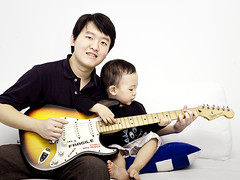Well this was the time when I got the chance to see a friend after quite sometime. In the process, he wanted me to shoot him with his family which I thought, hehmmm what sort of picture would be good for a family portrait, how to light them, what poses should I get them to do, etc2. So in the end of the day, because I didn't bring all my gear, I had to improvise with what I had.
In the first picture, he wanted me to shoot a picture of him and his son playing guitar together. I tried booming, then I realised I've come across and big problem of having a shadow behind him which I don't know how it got there until I saw the floor. It was pure white ceramic tiles which make a fine reflector. In the end, I decided to bounce of the ceiling as a fill and handhold my key light a little bit left of camera. I waited and waited and keep on snapping while talking to him and his son until I got this frame which shows the son was playing the guitar. Also because the son was a bit to short when photographed, I had asked for a pillow for him such that the balance of the picture is somewhat better.



